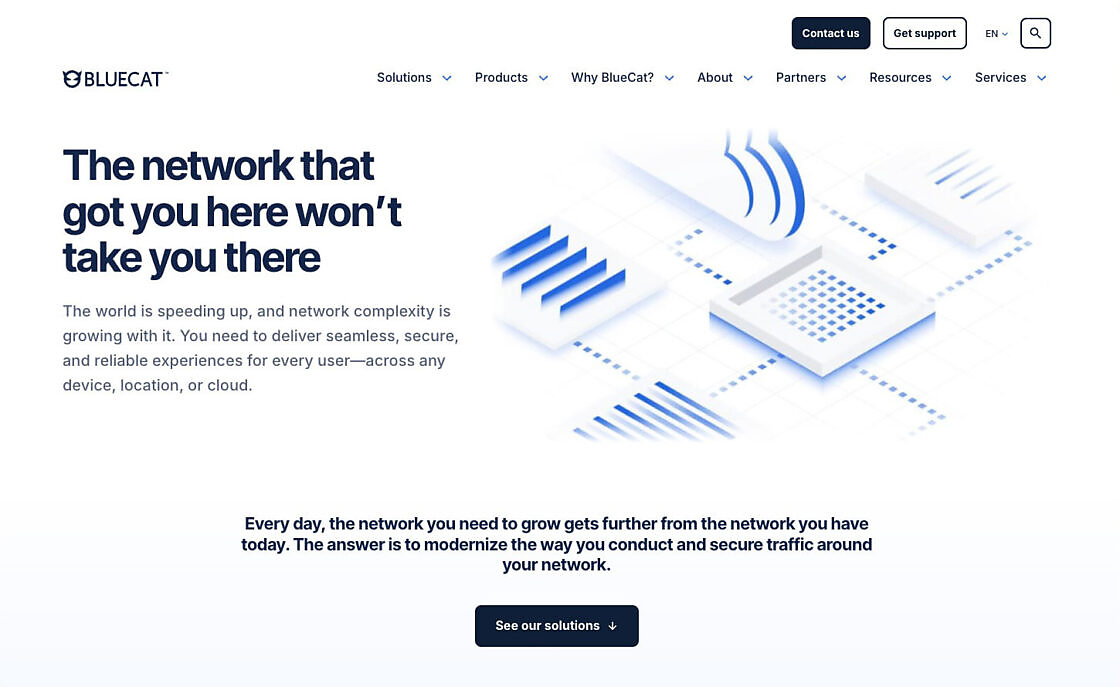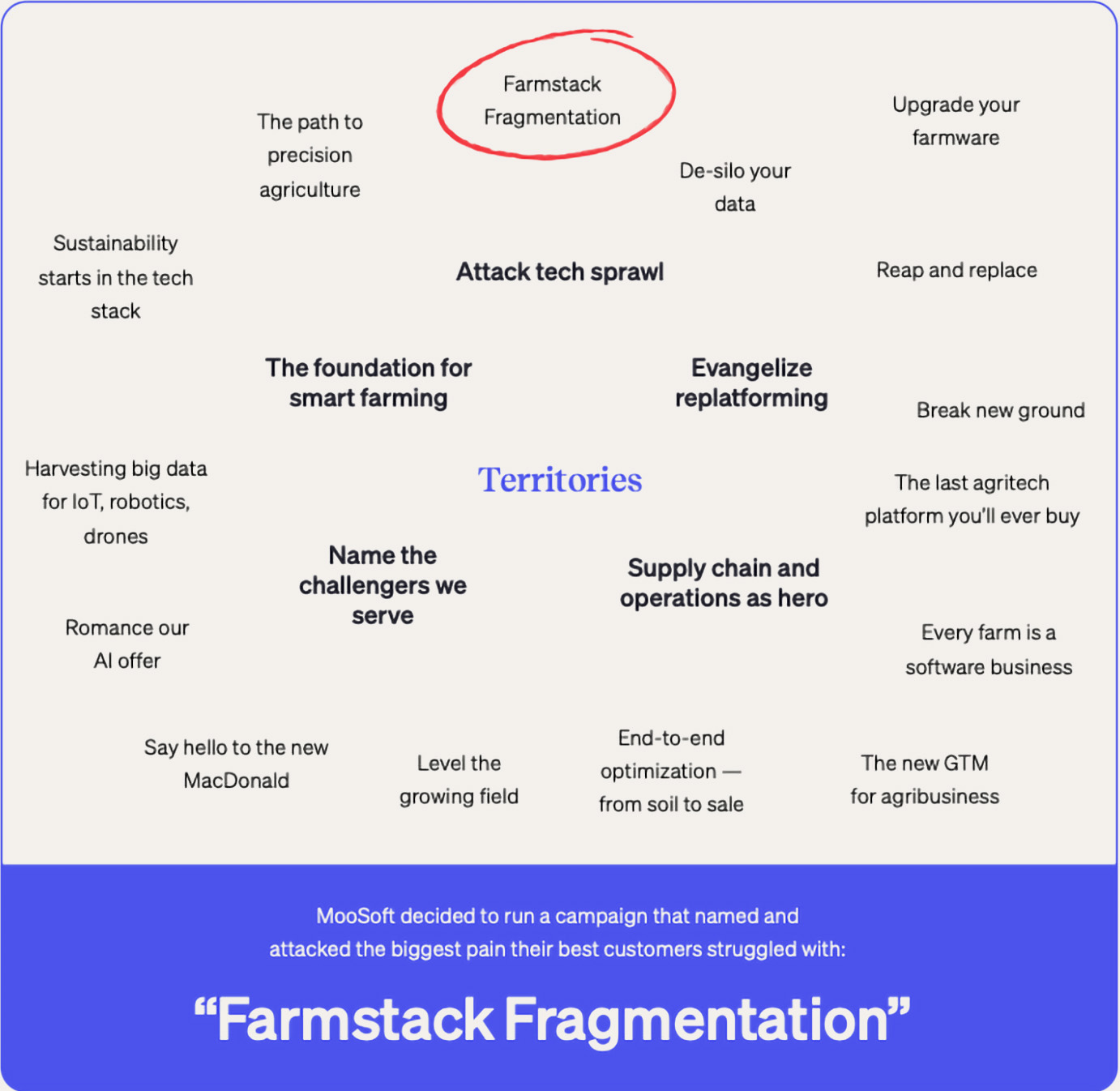The hardest chapter to write in the Big, Beautiful B2B Blueprint was about creative platforms.
And the reason is very simple: Creativity is a fucker.
What is a creative platform?
A creative platform is a foundational idea that inspires everything you need for a campaign — messaging, ads and content that grabs your ICP by the lapels and inspires them to act.
It’s more than a slick phrase or a clever line — it’s a new insight into your audience’s world that solves a problem or creates value for them in some way.
Developing an original idea that makes specific people stop scrolling (and maybe even take action) is one of the hardest parts of marketing.
It’s not something you can templatize or farm out to large language models. GenAI might be great to broaden your research horizons and remix extant stuff. But mine it for original thinking and you tend to hit slop pretty fast.
The most captivating ideas are A) fresh, B) specific and C) often grounded in things only you know (like the values, desires, pains and taste of your audience).
So while we can’t fill in the blanks for you (at least not without talking to you) we can take you through a simple brainstorming exercise we use to develop creative platforms for GTM blueprints.
(We talk about this process in way more detail in section 6 of the Big, Beautiful B2B Blueprint. Take a look. We don’t even want your email address for it.)
We’ve had a lot of success with this framework. We hope you do too.
Ready? Let’s do it.
Creative platforms start with creative territories
Sometimes you get a lucky bolt of inspiration and the perfect idea for a creative platform leaps out at you from the ether.
This is for the other 95% of the time, when it’s just you and the yawning tundra of a blank page.
It’s a simple brainstorming exercise that helps you get to specific ideas, by starting with broad themes and extrapolating them into different end-points.
Basically, it’s one big game of that-makes-me-think-of.
We’re going to look at some themes that apply to a lot of different B2B contexts (and look at some examples of how we’ve used them for clients). There are five of them:
- Attack your bad guy
- Make a hero of your users
- Empathize with an obstacle
- Name an aspiration
- Evangelize a new capability
It goes without saying these aren’t exhaustive. Maybe they’re directly applicable to your market. But the goal here is to tickle your that-makes-me-think-of muscle enough that you start exploring different themes that are more specific to your audience.
Here’s the first one.
Territory 1 – Attack your bad guy
Like we said in this post, every good story has a bad guy. Scaredy-cat marketers are terrified of negativity. But most companies exist because they solve a problem or serve an unmet need.
You’re not doing your audience any favors by pretending pain doesn’t exist. You know what is doing them a favor? Articulating it on their behalf.
It’s especially valuable in B2B because the problems can be hard to articulate. Attacking your bad guy is about giving a name to a pain that your audience feels but might not have a term for. It can be a way to say “hey, all these separate issues are actually part of one bigger issue — and we solve that.”
MooSoft™ (the definitely-not-made-up agritech company in our B2B Blueprint) were selling to agriculture companies struggling with disparate systems, which led to all kinds of downsides: manual management, inefficiencies, downtime, poor data quality and so on.
So MooSoft™ aggregated all these micropains into one macropain — spiraling tech spawl — and gave that macropain a name: Farmstack Fragmentation.
Most companies brand solutions. But branding the bad guy is a fundamentally more empathetic move. It’s a signal to your customers that you understand their problems, and that you’ve solved them many times before.
Where we’ve used this before:
We used this territory to lead into our creative platform for Hubspot. From our research that customers were tired of complex, inefficient CRMs, we created HubSpot’s “bad guy” as “Kludgy,” the pain of using cobbled-together, ineffective tech solutions.
Territory 2 – Make a hero of your users
Every bad guy needs a hero. But most marketers instinctively want to make their brand or product the hero.
But your customers are the main characters of their own lives. Showing them how you’ll help them become the best version of themselves is way more powerful than doing jazz hands around your software.
This is especially powerful in B2B because we have the luxury of substance — we make people better at their job. Credibility is much more brittle in B2C — go too far and you end up with Women Laughing Alone With Salad.
Your hero should be your ideal customer, living a better life because of your product.
The key here is to go narrow and specific rather than broad and aspirational. Think in moments.
- What small, private victories do you enable every day for your customers?
- How have their relationships and interactions changed? Who do they impress?
- What do they celebrate? What’s a goofy source of joy they didn’t feel before you?
Don’t confect this stuff from thin air. Ask your sales teams — and ideally, your customers. Chase anecdotes over data — you’re trying to get to surface feelings rather than cold, hard facts.
Where we’ve used this before:
For Calm for Business, their uniquely beautiful mental fitness hub needed to top the employee wellness market fast.
We created a new story for them that made HR leaders the hero of the story — that positioned them as enablers of greater productivity, culture and harmony at scale.
Territory 3 – Empathize with an obstacle
Empathizing with an obstacle is different from attacking a bad guy. You’re not finding a pain your audience feels but doesn’t have a name for — you’re focusing on the pain of change itself.
It’s a good territory to explore if you’re competing in a mature, crowded or undifferentiated market.
If the problem is well understood, or if the capabilities you provide are commodified, try breaking down (and overcoming) the causes of inertia — the things stopping your prospects from taking action. Take a stance in areas like:
- Evangelize a model of non-disruptive change
- Advocate for new priorities in the budget
- Advise on managing stakeholders and handling objections
- Appeal to a lower barrier to entry you enable (skills, cost, time, commitment)
- Identify a cycle you can break
One of the obstacles MooSoft™ explored in our B2B Blueprint was the pain of replatforming — the neverending treadmill of updating core systems piecemeal.
“The last agritech replatform you’ll ever need to buy” doesn’t start with MooSoft™’s capabilities, or even a pain point that customers would feel day-to-day. Instead, it acknowledges the short-term discomfort of change while romancing the long-term benefits of flexibility.
It’s particularly suited to prospects nearing a technology refresh, and changes the conversation from a laundry list of features or price comparisons to a longer-term and more strategic shift.
Where we’ve used this before:
BlueCat Networks provide core services (like DNS, DHCP and IP Address Management) for enterprise networks. The challenge was to position this deeply complex subject matter as an enabler of (or impediment to) larger network modernization projects that delivered a competitive edge.
One of the key lines we landed on was “The network that got you here won’t take you there.” Instead of getting lost in a feature fight, we situated BlueCat’s offering as an enabler of bigger transformational change.

Territory 4 – Name the kind of business your best customers become
A great way to inspire your audience is to show them a clear vision of what their business could look like with your solution, and give that future state a memorable name.
A lot of companies get caught up in trying to (re)define the category that they play in. The problem is that this can easily result in a bunch of terminology your customers have never heard of and don’t care about.
Instead of selling a new category to the market, sell a new kind of business to your prospects. What kind of organization could you help them become?
Put the camera back on them and they’re way more likely to see themselves in your marketing. Look at your best customers:
- How are they winning in ways that others aren’t?
- Why were they successful before you (and why would they still win without you)?
- What thing do you do best that helps them do what they do best?
The key is to make it feel like the next evolution of their business. With this, your audience can see themselves in a future they want to achieve, positioning your brand as the bridge to that transformation.
It’s more than marketing—it’s an invitation to become the best version of themselves with your solution as the catalyst.
Where we’ve used this before:
In 2018 Celonis needed a story to change the market’s perception of “process mining” from a technical and esoteric capability to something with huge strategic potential.
Rather than romance a new version of process mining, we developed a story about “The Superfluid Enterprise” — the kind of company sophisticated users of process mining become.
Territory 5 – Evangelize a new capability you enable
Evangelizing a capability you enable is different from promoting products, benefits or features. It’s about the thing that your customers can do that they couldn’t before.
This could be a new method of doing something that already exists, or a new activity or discipline altogether. Stuff like:
- An outcome-focused approach to analytics that’s only possible with the speed of insight you provide
- A new kind of customer relationship that’s only possible because of the way you empower agents
- A new kind of efficiency metric that’s only possible because of the degree of automation you provide
This territory is great to demonstrate your skin in the game. You’re not just providing products and services — you’re developing new ways of working that make the whole industry better.
Where we’ve used this before:
We developed a story for an inventory management software provider about why they helped product sellers evolve from “inventory management” to “Connected Inventory Performance.” and utilized a custom metric called Return On Inventory Management, to quantify how the efficiencies of Connected Inventory Performance impacted bottom line revenue — through dynamics like average basket size and higher customer lifetime value.
What to do next
And there we have it. Those are five example territories worth exploring as you think about the creative platforms that’ll support your marketing in 2025.
We explored all of these through the lens of MooSoft™, with example follow-up ideas, on page 31 of the Big, Beautiful B2B Blueprint Workbook — check it out:

It’s not terribly sophisticated, but the best ideas seldom come from stuffy frameworks and templatized thinking. Territory mapping is a simple and reliable brainstorming exercise that provides just enough structure to keep you in a creative and productive associative thinking sweet spot.
Try this out for a future campaign — you’ll almost certainly find that there are other territory themes worth exploring that are even more dialed in to the specific needs of your buyers and dynamics of your market.
Start planning now
The Big Beautiful B2B Blueprint comes with a companion template you can use to start planning today. The exercise for creative platforms is on slide 14.


Enjoyed this article?
Take part in the discussion








Comments
There are no comments yet for this post. Why not be the first?